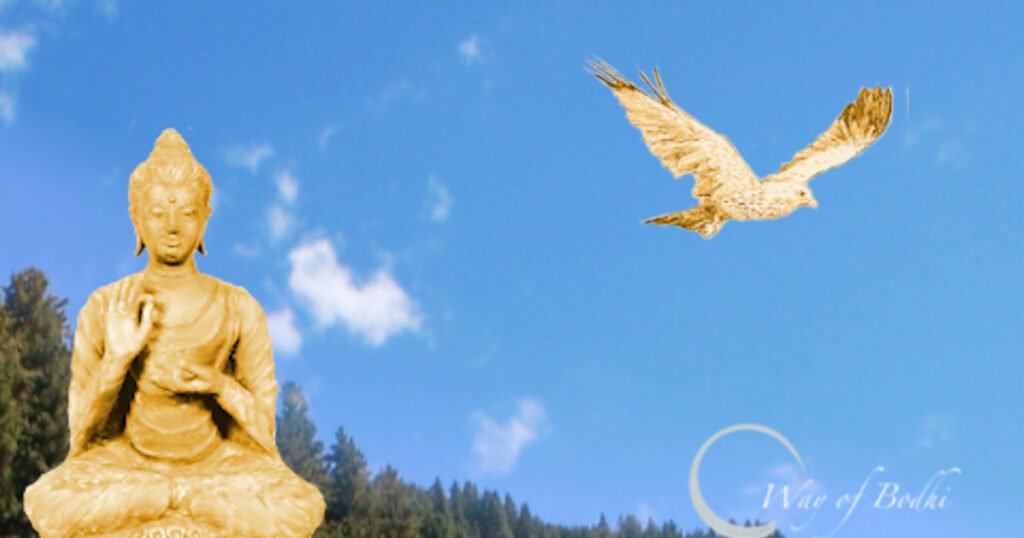Like a bird flying through the vast expanse

The simile of a bird in flight in various Buddhist teachings
A bird in flight is a commonly used simile in the teachings of the Buddha in various contexts. Let us see and understand its meaning in some of those scopes. At different contexts this simile indicates tracelessness, groundlessness, unobstructedness and effortlessness.
We can see the simile in Pali suttas and Dhammapada. With a deeper meaning, we can again see the simile in Prajñāpāramitā sutras of Mahayana. While the bird simile is used to indicate the fruition of the path in these teachings, a simile of the effortless gliding of the bird Garuda comes in Dzogchen teachings to indicate the path.
यथ ते भवन्ति विदु आशयसंप्रयुक्ता
दिवरात्रि प्रज्ञवरपारमितार्थदर्शी।]
तद कायचित्त खगपक्षिसतुल्यभूता
अवतारु सो कुतु लभिष्यति कृष्णबन्धुः॥
yatha te bhavanti vidu āśayasaṃprayuktā
divarātri prajñavarapāramitārthadarśī|
tada kāyacitta khagapakṣisatulyabhūtā
avatāru so kutu labhiṣyati kṛṣṇabandhuḥ||
When the wise see the supreme perfection of wisdom,
Day and night, with resolve firm,
Like a bird in the spacious expanse are their body, speech, and mind,
How can the kinsmen of darkness manifest to them!
– Prajñāpāramitā Ratnaguna samcaya gātha (The Verses on the Perfection of Wisdom) Verse 217 (Note 1)
A Bodhisattva becomes free like a bird in the open expanse – traceless, groundless, and unobstructed – through the cultivation of wisdom insight. Neither abiding in the peace of Nirvana nor succumbing to the abysmal suffering of Samsara, he or she courses through the open expanse of the phenomenal world. Bodhisattva cultivates wisdom insight through phenomena – as they arise, abide and vanish – day and night, in waking state and in dreaming and in deep sleep. With a resolute intent, he or she penetrates phenomena and investigates their essence. Once a Bodhisattva perfects the wisdom, that of seeing all appearances as empty of inherent existence (svabhāva-śūnya) and merely illusion-like (māyopama), he or she is completely free from clinging to phenomenal appearances.
To a Bodhisattva who attained the perfection of Wisdom, even the Maras, the personification of obstacles, the kinsmen of darkness, are powerless. The obstructions and harm can manifest only when there is ignorance and clinging (updāna). Thus, a Bodhisattva experiences his body, speech and mind like the flight of a bird through the vast expanse of space. There is no obstruction, and there is no trace left. He or she is free to be in Samsara for the benefit of others. Samsara does not bind. Nirvana does not make a special abiding ground. This is unlike ordinary beings, who experience obstructions and harm through the power of clinging.
Another verse in the same text, Ratnagunasamcaya Gatha Verse 173, also evokes the simile of a bird in flight. It states,
पक्षिस्य नास्ति पदु गच्छत अन्तरीक्षे
नो चापि तत्र स्थितु नो च पताति भूमौ।
तथ बोधिसत्त्व चरमाणु विमोक्षद्वारे
न च निर्वृतिं स्पृशति नो च निमित्तचारी॥
pakṣisya nāsti padu gacchata antarīkṣe
no cāpi tatra sthitu no ca patāti bhūmau|
tatha bodhisattva caramāṇu vimokṣadvāre
na ca nirvṛtiṃ spṛśati no ca nimittacārī||
A bird in flight has no footing in space.
Neither does it stay in space, nor does it fall to the ground.
Likewise, the Bodhisattva who glides in freedom.
Neither does he stay in Nirvana, nor does he course in signs (Samsara).
The simile of a bird in flight also comes in the Pali collection of the words of the Buddha. In Dhammapada (verse 92, 93), a freely flying bird in the sky that leaves no trace is used as a metaphor for an Arhat. An Arhat is one who has destroyed all karma and won over afflictive emotions, whose path does not leave a trace of karma.
yassasa va parikkhinaahare ca anissitosunnato animitto cavimokkho yassa gocaroakaseva sakuntanam padam tassa durannayam.
They (Arhats) are free from mental fermentations (āsavas). They are not attached to food. Their field of seeing is the liberation from existence (vimokkha) that is Empty (suññata) and Signless (animitta). Their way, like the course of birds in the air, cannot be traced.
-Dhammapada Verse 93
In the context of Prajnaparamita (such as in the verse above from Ratnaguna samcaya gātha), the flying bird is not only gliding without leaving a trace (of karma), but also gliding in an open expanse free of obstructions (that is the mark of realizing the emptiness of all phenomena)
While the simile of a bird in flight is used to indicate the fruition of an Arhat and Bodhisattva respectively in the Pali collection and Prajñāpāramitā, the same simile is used to indicate the path of a Yogi in Dzogchen (Atiyoga) teachings of Buddhism.
For example,
Without entering into the narrow rocky gorge
Of a mind striving for stillness or movement,
Without being caught up by the notions of
Conceptually contrived View and Meditation,
Without slipping into the dark clouds of mental dullness,
Without plunging into the storm of agitated thoughts,
The mighty Garuda, my own mind,
Flew freely in the wide open sky of the natural expanse!
-Shabkar, a Dzogchen yogi of Tibet in his ” Song of Guru and Triple Gems”
In Dzogchen, not just a bird, but particularly the example of Garuda, a bird that majestically and effortlessly glides through the open expanse, is used. This is to indicate the absence of contrived mental efforts in the way of Dzogchen.
Note 1
Ratnagunasamcaya gatha is the verse summary of the Aṣṭasahasrika Prajñāpāramitā sutra – the Perfection of Wisdom in 8000 lines. Aṣṭasahasrika is thought to be the oldest of among the Prajñāpāramitā sutras and became popular around the 1st century BCE.
Note 2
Arhats see the Emptiness and Signlessness of Nibbana. In the Bodhisattva path, Emptiness and signlessness of all phenomena including that of Samsara is realized, thus seeing Samsara and Nirvana as one in nature.
- Like a bird flying through the vast expanse - September 21, 2021
- The Liberation Story of Punnika, a Girl from an Oppressed Caste - March 31, 2021
- Ancient Buddha Statues of Kerala - October 11, 2018

